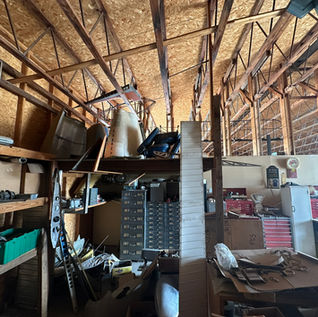
Open During Special Events and
By Appointment
THE CALDWELL COLLECTION AT MUSTANG FIELD
Uncovering the 1929 Lincoln Page PT-W
There were hundreds of airplane manufacturers springing up all over the country in the late 1920’s. It was a time of exuberant, seemingly inexhaustible growth and economic enthusiasm. Since the end of the war the technology of aviation had been expanding at a bewildering pace. Airlines were not only carrying the mail but passengers too. Businesses were finding increasing uses for airplanes and the public’s fascination piqued by barnstormers and fueled by huge national air races was at a fever pitch.
In 1927 Charles Lindberg crossed the Atlantic Ocean and entrepreneurial interest in aviation exploded. The Collection’s Lincoln (for the company was not yet called Lincoln Page) wasn’t the first airplane to be built by this Nebraska startup but it was among the last. Built by late summer 1929 it was sold and in service just months after the Black Friday stock market crash in October. While the company, formed in 1922 was gone, like many others, by 1932 but NC561M would carry on in its role as trainer for another decade or so until it disappeared for nearly thirty years.
The Lincoln Page Aircraft Company started in business in 1922 fixing up war surplus Curtiss Wright JN4’s (Jenny’s) and their OX5 engines. In the same year a motorcycle distributor named Victor Roos got into the airplane business with a partner buying the aviation assets of Maryland Pressed Steel company and former Roos-Bellanca and creating the roots from which a number of famous airplane companies sprang including the Bellanca company itself.
Roos-Bellanca only lasted a few years but as it folded Roos became the general manager of The Swallow Aircraft Company. This was shortly after key Swallow employees Clyde Cessna, Walter Beech and Lloyd Stearman had left the company over a disagreement with its owner. This trio went on to form Travel Air which, for a time, was the world’s leading aircraft maker.
Cessna himself left Travel Air in 1927 and he and Roos formed, for a time the Roos-Cessna Aircraft Company. But Roos, the largest shareholder in the new venture, left within a month. Meanwhile Swallow was bankrupt and Roos took it over briefly. In 1928 Roos joined American Eagle and then he and his partners agreed to merge with Lincoln Aircraft becoming American Eagle-Lincoln. Ultimately, as all these companies and combinations folded during the depression Roos went on to become a jukebox distributor.
But before Lincoln’s ultimate failure they produced several notable airplanes including the LP3 sport plane and the PT series (primary trainer). The PT is an interesting airplane. It is much cruder in design than many of its contemporaries like the Waco 10. And it bears a striking resemblance to the Swallow, likely because of Victor Roos himself. Not a commercial success there were only 56 PT’s ever built with a variety of engines. Of those only 5 were built with Warner Scarab engines.
This Warner engine, which powers NC561M (in fact, unusual for a nearly 100 year old airplane NC561M is still powered with the original engine it left the factory with), is also fairly crude compared to others made at the same time. Warner introduced this motor in 1928 but it still featured open rockers like the venerable OX 5 and parts of the cylinder head are bolted on brass because they had not yet perfected casting aluminum at right angles. Of course, it is also a “greaser” as overhead oiling of rocker boxes was a development still a few years distant.
NC561M entered service in late 1929 and bounced around among a number of commercial owners moving steadily westward until it ended up in Idaho in 1943. As the sales took place the plane’s manufacturer was called Lincoln Aircraft Company and Ultimately Lincoln-Page. It disappeared from the FAA’s record sometime between 1943 and 1950 where it remained officially unknown until 1971 when Jim Hayden reapplied for registration. For some reason Jim described the airplane as a “Roos Lincoln” when he reapplied for registration in 1995 and that is what it is now known as.
Mr. Hayden, an active aircraft and automobile restorer, completely rebuilt the airplane in 1976. It’s history for the next three decades is unclear as Mr. Hayden’s son reported that it wasn’t flown for a very long time and was likely stored away in Caldwell, Idaho for the next three decades when it was restored again and a conformity inspection was approved in 2006. From then for the next 15 years the plane was flown intermittently accumulating about 300 hours until Mr. Hayden passed away leaving it to be found by The Collection covered with dust and surrounded by auto and airplane parts in a dilapidated barn on a small airport populated mostly by junk.
Underneath the dirt lay a remarkable time capsule with virtually all the original equipment it left the factory with 96 years earlier including original instruments, 30x5 wheels and brakes, and notably its Warner engine.


The Big Barn Find






























